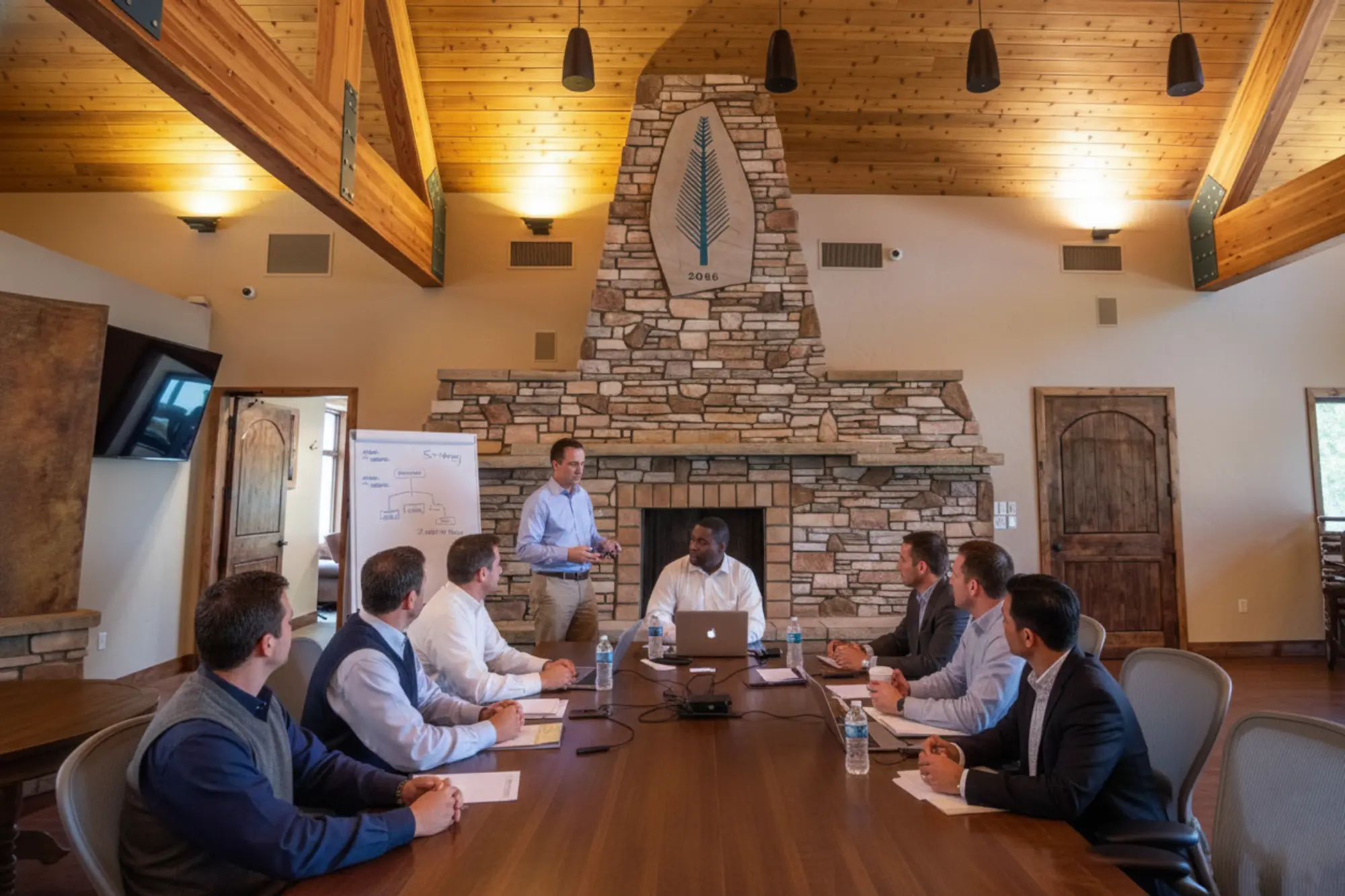An offsite meeting takes your team out of the office to foster creativity and enhance collaboration. It disrupts the routine, allowing for open communication and new ideas.
In this post, we’ll explore the benefits of offsite meetings and why choosing the right venue can make all the difference in achieving your team’s goals.
Key Takeaways
- Offsite meetings offer numerous benefits including breaking the daily routine, fostering team building, promoting strategic planning, and providing a conducive environment for open communication and idea generation.
- Successful offsite meetings require meticulous planning, clear goal setting, selecting an appropriate venue, and creating a detailed agenda to ensure productive use of time and resources.
- Effective follow-up after an offsite meeting is crucial, which includes sending a summary email, collecting feedback through surveys, and assigning actionable steps with clear accountability to ensure the implementation of ideas discussed.
Understanding Offsite Meetings
Imagine a meeting where the walls of cubicles are replaced by the tranquility of a natural setting, providing a refreshing and inspiring environment. This is the essence of offsite meetings, where the setting alone can inspire innovation and strategic thinking. When your team steps out of the everyday work environment for offsite meetings, it sparks creativity and encourages everyone to think outside the box and share ideas they might otherwise keep to themselves.
The advantages of offsite meetings include:
- Disruption of the daily grind
- Building stronger teams and a more dynamic company culture
- Catalyst for team building
- Fostering advanced thinking
- Setting the stage for short-term troubleshooting and long-term strategic planning
- Providing a relaxing and conducive atmosphere for meaningful dialogue
Offsite meetings are not just about finding new surroundings, but also about creating a more productive and collaborative work environment off site. The unique environments chosen for offsites, play a significant role in enhancing the overall experience.
On-site vs. Offsite
While the traditional on-site meeting has its place in the day-to-day operations of a business, the allure of offsite meetings lies in their ability to offer a fresh perspective and a stimulating environment. Think of on-site meetings as the steady heartbeat of your company’s workflow, maintaining a sense of familiarity and routine. However, this very familiarity can sometimes be a barrier to the creative stimulation that offsite events provide.
Moving from the office to an offsite venue can be compared to opening a window to welcome fresh ideas and a rejuvenating breeze. It encourages team members to break free from the invisible boundaries that office walls can impose, promoting a sense of freedom and possibility that is essential for a successful offsite meeting. Whether it’s for strategic planning or team building, offsite meetings offer the chance to escape the noise of daily tasks and focus on the bigger picture in a setting that invigorates the mind and spirit.
Key Objectives of an Offsite Meeting
Offsite meetings, also known as team meetings held outside the office, typically aim to:
- Build a unified team that is strategically aligned
- Promote open communication
- Establish a shared understanding of the company’s strategic goals
- Motivate team members
- Ensure that everyone is paddling in the same direction
- Transform into a breeding ground for brainstorming sessions and strategic planning
- Improve team accountability
- Create a clear action plan moving forward
When conducted in the right atmosphere, an off site meeting can be highly effective in achieving specific goals.
Moreover, the safe environment that an offsite venue offers is conducive to open and honest feedback, which is crucial for the growth of both individuals and the company as a whole. It is in these settings, away from the usual office distractions, that teams can truly engage in meaningful discussions about larger projects and the company’s future, fostering a sense of collective responsibility and commitment to the company’s success.
Planning Your Next Offsite Meeting
Successful offsite meetings are anchored in meticulous planning. This is the stage where you set the stage for increased productivity and employee satisfaction. It’s here that you’ll establish what you want to achieve, who should attend, and how to best structure your time together. With a clear and well-communicated agenda, the next offsite meeting can become a milestone event for your team, setting the tone for the company’s future development.
But planning isn’t just about the itinerary. It’s about understanding your budget, setting ground rules for participation, selecting the right meeting venue, and ensuring that every team member is prepared to contribute. By communicating goals and expectations ahead of time, you empower your team to bring their best ideas to the table, making the most of the precious time spent away from the office.
Defining Clear Goals
As you begin planning your next offsite event, start with a definite set of objectives. What are the strategic goals you wish to achieve? How will you measure the meeting’s success? Defining these goals early on ensures that your meeting maintains its focus and drives productivity, rather than becoming a listless gathering.
Attempting to cover too much ground can scatter your team’s focus, making the session less effective. It’s more strategic to hone in on a few key objectives that can realistically be achieved in the time allotted. This not only makes the meeting more manageable but also more rewarding for participants, as they can see tangible outcomes from their discussions and efforts.
Choosing the Right Offsite Venue
The meeting venue for your offsite meeting should:
- Be accessible to all invitees
- Provide a comfortable setting that supports the meeting’s objectives and planned activities
- Fit your group comfortably
- Offer amenities required for a productive meeting, such as tech support for presentations, ample parking, and facilities like restrooms.
The ambiance of the venue should align with the goals of your meeting – whether it’s fostering creativity, strategic planning, or team building. It’s not just about finding a space; it’s about choosing a venue that complements the agenda and enhances the experience for every participant.
Creating an Effective Offsite Meeting Agenda
Creating an effective offsite meeting agenda can be compared to designing a treasure map. Each activity, time allocation, and participant responsibility should be detailed, guiding the team towards the meeting’s objectives. When the agenda is well-aligned, each session can receive the attention it deserves, maximizing the chances of achieving the desired outcomes.
For offsites lasting at least two days, the agenda can afford to include ample time for in-depth discussions, brainstorming, and, equally important, team bonding. If structured properly, this balance allows for both productive work and the downtime necessary for team members to recharge and socialize, setting the stage for great ideas to emerge.
Maximizing Team Communication and Bonding
Offsite meetings reach their true potential when they serve as platforms for boosting team communication and camaraderie. Through a mix of work-related activities and team-building exercises, an offsite meeting can strengthen bonds and spark creativity amongst team members. By incorporating exercises that emphasize trust, the team’s morale can soar, paving the way for a more cohesive and collaborative working environment.
Some examples of team-building exercises that can be incorporated into an offsite meeting include:
- Group problem-solving activities
- Icebreaker games
- Outdoor team-building activities
- Team-building workshops
These exercises can help foster trust, improve communication, and enhance teamwork within the entire team.
Engaging in collaborative projects and creating shared goals during offsite meetings can align team efforts, resulting in improved overall collaboration and communication. Additionally, icebreaker activities can serve as a gentle nudge for team members to step out of their comfort zones, fostering connections that go beyond the professional realm.
Breakout Sessions
Breakout sessions, often used as training sessions, are the secret sauce to fostering in-depth exploration and problem-solving in smaller teams. By assigning specific topics to different groups, you create an environment where focused, productive discussions can flourish. These sessions not only encourage brainstorming and creative thinking but also allow team members, especially those who are more introverted, to voice their ideas in a more comfortable setting.
Think of breakout sessions as mini think-tanks within the larger group. They offer a chance for a deep dive into subjects, facilitating a level of detail and engagement that might be challenging to achieve in a full-group setting. Plus, the variety of perspectives brought together in these smaller groups can lead to innovative solutions and stronger team cohesion.
Open Communication
Successful offsite meetings thrive on open communication. It’s the vehicle through which conflicts are resolved, and trust is built. Managers play a pivotal role by actively soliciting employees’ thoughts and opinions and practicing reflective listening. This establishes a platform for honest dialogue.
To facilitate this, managers must demonstrate respect by giving full attention to team members during conversations. Such a respectful approach encourages employees to share new ideas freely and contributes to a culture of open communication that extends beyond the offsite event.
Social Events
Social events during an offsite meeting serve a dual purpose; they offer enjoyment and act as strategic tools for fostering personal connections among team members. These informal settings, such as team dinners or outings, allow colleagues to interact on a personal level, strengthening the bonds that are essential for effective teamwork.
Some team building activities that can help team members bond and appreciate the company culture in a new environment include:
- Outdoor activities
- Cooking workshops
- Historical tours
- Volunteering
These shared experiences contribute to team cohesion and team spirit, reinforcing the sense of belonging and commitment to the company’s vision and company’s future.
Post-Meeting Follow-Up
While the offsite meeting might have concluded, the pursuit of its goals has just commenced. A well-executed post-meeting follow-up is important for reinforcing key points and ensuring that action items are completed. Sending a summary email that recaps the meeting and outlines the next steps helps keep everyone on track and maintains the momentum generated during the offsite.
Creating a shared document or platform for additional comments or ideas can also encourage ongoing dialogue and contribution, ensuring that the meeting’s impact continues to resonate long after the team has returned to their daily roles. Regular check-ins to monitor progress on tasks and holding individuals accountable for their assignments are vital to turning the strategic plans and creative ideas into reality.
Collecting Feedback
The success of future offsite meetings hinges on the ability to learn from each one. Collection of feedback is an integral part of this learning process, offering insights into success areas and potential improvements. Specific questions about the meeting’s various aspects can elicit honest responses that are invaluable for planning the next offsite event.
Online surveys or feedback forms are effective tools for gathering opinions on the effectiveness of the meeting. This feedback helps identify areas that require attention and allows planners to tailor future offsites to the team’s needs, ensuring continuous improvement and satisfaction.
Action Plans and Accountability
Strategic goals and brainstorming sessions from the offsite meeting need to be converted into actionable steps. Here are some tips for doing so:
- Assign action items to specific individuals with clear deadlines.
- Foster a sense of accountability by holding team members responsible for their assigned tasks.
- Summarize next steps in a follow-up email to serve as a reminder of the commitments made during the meeting.
By following these steps, you can ensure that ideas don’t remain in the realm of theory and that progress is made towards achieving your goals.
- Regular check-ins to review progress on larger projects:
- Prevent tasks from falling through the cracks
- Keep the team aligned with the strategic agenda
- Maintain the focus and energy required to transform discussions into action
- Ultimately, lead to successful outcomes for the business.
Summary
As we draw this guide to a close, it’s clear that the art of a successful offsite meeting lies in thoughtful planning, fostering an environment of open communication, and nurturing the bonds that tie a team together. Each carefully chosen venue, meticulous agenda, and engaging team-building activity plays a significant role in shaping the future of your team and, by extension, your company.
Let this be the catalyst for your next offsite meeting, a stepping stone towards a more innovative, cohesive, and motivated team. Embrace the strategies shared, and watch as your team transforms challenges into opportunities, ideas into actions, and meetings into milestones.
Frequently Asked Questions
What are the main benefits of holding offsite meetings?
The main benefits of holding offsite meetings include fostering creativity, encouraging team building, aligning team members with strategic goals, and providing a change of environment that enhances communication and strengthens company culture. Hold offsite meetings to reap these advantages.
How do offsite meetings differ from on-site meetings?
Offsite meetings provide a fresh perspective and stimulating atmosphere that can inspire creative thinking and strategic planning, while on-site meetings take place in the familiar office setting, often suited for routine tasks. Therefore, offsite meetings offer a different environment for better creativity and strategic planning.
What should be included in an offsite meeting agenda?
An offsite meeting agenda should include a detailed plan of activities, time allocations, participant responsibilities, and be aligned with the meeting’s strategic goals to ensure focus and productivity. This will help in organizing the meeting efficiently and achieving set objectives.
How can team building activities during an offsite meeting improve team dynamics?
Team building activities during an offsite meeting can enhance trust, boost team morale, and encourage open communication, ultimately leading to improved collaboration and team cohesion.
Why is post-meeting follow-up important?
Post-meeting follow-up is important because it reinforces key points, ensures completion of action items, collects feedback, and maintains accountability, which is crucial for successful implementation of discussed ideas.



